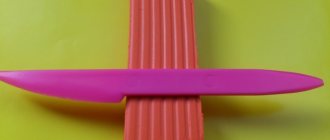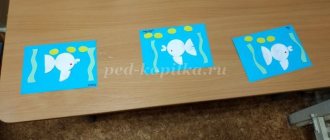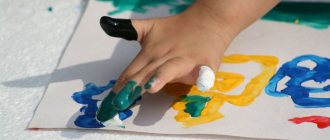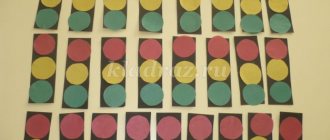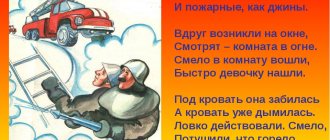Goal: development of independence, active skills of joint activities of children in the classroom. Training sessions: Strengthen the ability to draw strokes with pokes in a certain order, learn to paste ready-made shapes (circle) in a certain order, focusing on a sample. Developmental objectives: to develop children's sensory abilities - to recognize and distinguish between red, blue and yellow colors. Speech tasks: encourage the use in active speech of words denoting objects (sea, fish) and signs of objects (red, blue). Educational tasks: to develop independence and activity when choosing the color of the created image of a fish, type of activity; cultivate accuracy when choosing visual materials. Materials: “Sea” manual, a blue or light blue piece of fabric measuring 1x1 m “with seaweed” in red and yellow. Yellow and red paper fish attached to the front of the fabric. White fish “swimming” among the “algae”. Red and yellow paint (gouache), glue, red and yellow ready-made shapes for applique (circles), glue brushes, napkins, pokes, fish holders. Preliminary work. Exercise children in drawing with a brush and paints in the classroom; development of the ability to recognize and name red, blue and yellow colors; round dance game with the manual “Sea”.
Progress of the lesson:
1. Introductory part. Educator: Guys, look what we have. This is a blue, blue sea. In one distant country there is an amazing blue, blue sea. And two fish live in it - red and yellow. Do you see them? What color are they? When was the sea rough? (Swings the fabric faster) - that’s how it was worried - the fish were splashing around in the blue water. Like this. Sometimes our fish swam to the very bottom of the sea. Quickly and quickly raise your arms up and immediately lower them smoothly (3-4 times). Let's see what's there at the bottom of the sea. Who saw what? Educator: That's right, the fish there are white. What color are our fish? Red and yellow, and soon they became sad. Look how sad they have become. Sad fish? Do you know why? Because they had no friends - other red and yellow fish. Do you want to help them? Then sit down on your chairs, and I will tell you how you can do it. Finger game:
The fish swam, the fish swam, waved its tail, waved its tail, feed it quickly - it will be more fun to swim!
Educator: To help our fish, we need to make the white fish colored - red and yellow. You can color the fish with paints or with colored paper. Who wants to do what?
2. Main part:
(With the help of the teacher, children are seated at two tables)
Educator: Guys, please choose what color fish you will make - red or yellow? Look how I decorated my fish. I glued yellow circles between these stripes. Show with your finger where you will glue.
(The kids get to work, the teacher watches how the children hold the brush, spread glue on the finished forms, and glue them onto the finished bases)
Educator: Guys, look how I will decorate my fish. I want to decorate a yellow fish, so I take which fish? (Yellow). Now please choose paint colors for your fish.
(While the children are working, the teacher carries out individual work: he completes the drawing of the eye, shows how you can play with her - how she swims, how she opens her mouth, wags her tail)
3. Final part:
The teacher, with the help of the children, attaches the fish to the blanket with clothespins: red fish are near the red fish (these are her friends), yellow fish are near the yellow one. At the same time, children are asked questions.
Conversation on issues. — What color is your fish? - Which fish did she make friends with - red or yellow? — How did you paint the fish? - Did you like what you did? Educator: now our fish have many friends, they are happy. They play again, have fun and laugh. Let's see how they do it?
We are small guys, small, remote, we stood together around the sea, we raised the sea with the fish, and walked in a circle. We go, we go, we go in circles, and we squat down!
Author: Gabibullaeva Firoza Pashaevna, teacher of MBDOU DSKV No. 10 “Squirrel”
The article is published in the author's edition
Summary of a drawing lesson in the second nursery group “Fish”
Lolita Tseretyan
Summary of a drawing lesson in the second nursery group “Fish”
Let's color the fish .
Goal: learn to hold a brush correctly, dip it in paint, paint inside the outline, recognize and correctly name the color orange, form the correct posture when drawing .
Children complete the task. The teacher asks the children to name the toy and its color, for example: orange cube, orange ball, etc.
Well, you know the color orange well. Can you find orange paint among the paints? (Children complete the task)
.
Yes, we will use this paint to paint our fish . Only we will probably need an assistant. We will not paint the fish with our fingers . Look what the mouse brought us. (Shows a toy mouse with a brush in its paws)
. This brush is our assistant. She has a soft tail and a long handle. But you need to be able to hold the brush correctly. Otherwise, she will be offended, and our drawing will turn out ugly and sloppy. Let's learn how to pick up a brush correctly.
On the topic: methodological developments, presentations and notes
Topic: “Visiting the circus horse” Goal: Enrich children’s knowledge about the circus and circus professions. Objective: Educational: Introduce children to the Irkutsk circus, expand knowledge about circus workers.
Lesson notes on space.
Introduce children to the season - autumn, tell what changes in nature occur in autumn.
Construct (summary) of a lesson in the second junior group on artistic and aesthetic development “Let's help the hedgehog.”
Open lesson on artistic and aesthetic development (drawing in an unconventional way - with fingers) Goal: development of creative abilities in children, through non-traditional means.
Dear Colleagues. I bring to your attention a summary of a lesson on introducing children of the younger group to fiction. The fairy tale brings magic into the world of children, teaches them to distinguish between good and evil, p.
Goal: Creating a drawing according to the child’s plan. Program objectives: Educational: Teach to see and highlight beautiful objects and phenomena. Strengthen children’s ability to draw with different materials, choosing them according to their own.
Source
Progress of the lesson:
Reading the fairy tale " Tales of the Goldfish "
A.S.
Pushkina
And now let's play. Come out onto the carpet.
The sea is agitated once
The sea is worried two
The sea is worried three,
how fish swim !
(Feet shoulder-width apart, swinging arms from right to left, imitating waves)
The fish swam and dived
In blue sea water.
They will bury themselves in the sand.
(Hands in front of the chest with folded palms, running in all directions, bending, moving closer and further apart, squatting).
And now I suggest you draw a goldfish .
Drawing " Goldfish "
Notice what shape the fish's ? What color is the goldfish ? the fish have ?
Showing the progress of the work.
Children doing work with background music.
Showing the progress of the work.
Children doing work with background music.
Children lay out their finished works on a common surface.
Guys, do you like the drawings of your comrades? Which drawings did you like? Why did you like them?
Guys, let's get creative. What would happen if a goldfish offered to make our wishes come true? What would you ask a fish ? Think! So I would ask the fish for peace throughout the whole earth.
What are your desires?
Children tell their wishes , and the teacher writes them on the back of the drawing.
Photo report on the All-Russian quiz for preschoolers at MAAM “The Tale of the Fisherman and the Fish” Photo report on the All-Russian quiz for preschoolers “The Tale of the Fisherman and the Fish”.
It was decided to hold it in our group on May 10th. To the birthday of A.S. Pushkin. Reading the fairy tale “The Tale of the Fisherman and the Fish” Goal: to continue to introduce children to the biography of A. S. Pushkin and his fairy tale “The Tale of the Fisherman and the Fish.” Objectives: Deepen and expand knowledge. Notes on drawing in the senior group “Goldfish” Goal: To develop the ability of children to depict images large, on the entire plane of the sheet, to maintain proportionality between parts of the image; Summary of a lesson on speech development “Tales of A. S. Pushkin” and making an applique “Golden Fish” Maria Manvelova Summary of a lesson on speech development senior preparatory group “Tales of A. S. Pushkin” Application “Golden Fish” Purpose:.
Master class on crafts from waste materials “The Tale of the Fisherman and the Fish” Like most educators, I do not throw away packaging containers. What if it comes in handy at work? So I looked closely at the vegetable mesh for a long time. Our participation in the all-Russian quiz for preschoolers “The Tale of the Fisherman and the Fish” Our favorite site pleases us with new competitions and diplomas. And one of these new gifts was the opportunity for us to participate together with our own. Source
Summary of a drawing lesson on the topic “Visiting the Fish” (junior group 2)
Visit the fish
(2nd junior group drawing lesson)
Goal: to develop children’s artistic and creative abilities using an unconventional drawing technique - “Palm Drawing”
.
Tasks:
· Educational: introduce children to the “Palm Drawing”
.
· Developmental: develop perception, imagination and memory.
· Educational: cultivate a caring attitude towards materials, use them correctly: upon completion of work, put them back in their place.
Material:
· drawing aprons for each child, a fish, a duck, a fitness track, a basin of water
· sheet of paper in the shape of an aquarium, gouache, brush, napkins
Progress of the lesson:
Educator: Guys, today we will go to visit the fish. Do you know where the fish lives?
Children's answers.
Educator: That’s right, the fish lives in the water. And so that you don’t get your clothes wet, we’ll put on aprons and go on an exciting journey. (The teacher puts on aprons).
Educator: and now let’s go on a journey to the fish. Let's turn into fish and swim to them.
The teacher reads the verse and shows the movements, and the children repeat:
Fishes swim and dive in clean, warm water.
(We perform wave-like movements in the air and walk along the health path).
Either they will shrink, they will unclench, or they will bury themselves in the sand.
(Palms are closed and slightly rounded. We perform a “diving” movement with them)
Educator: Here we are. Look, guys, what do we have here? (there is a bowl of water in front of the children). That's right, water, and there's a fish in it. What is she doing? (floats)
Tell me, what kind of fish? What does she have? Children describe the appearance of the fish. The teacher asks questions.
Educator: That's right, the fish has a head, eyes on its head, they are large and round. There is also a tail and fins. When a fish swims, it moves its tail and fins. Guys, let's count? (counts). Tell me how many of you are there? (a lot of). How many fish are there in the water? (one).
Guys, let's help our fish find a lot of friends. We will draw fish on this piece of paper. I prepared different colors. Which? (children call), but forgot to bring brushes. But you and I can also draw with our palms. Remember how we did it.
The teacher clarifies the palm drawing technique.
Independent work of children with musical accompaniment. As the activity progresses, the teacher helps and reminds about the careful use of paints.
Educator: Look how many beautiful fish you have drawn. Let's get our hands in order (clean our hands of paint with napkins).
The teacher leans towards the water and listens.
Educator: Guys, the fish told me that she really liked the new friends you drew (praises each child) and says thank you. Let's say thank you and say goodbye to the fish.
